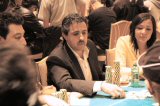SECTION 8-10
SECTION 8 – SEVEN-CARD STUD
Seven-card stud is played with a starting hand of two downcards and one upcard dealt before the first betting round. There are then three more upcards and a final downcard, with a betting round after each, for a total of five betting rounds on a deal played to the showdown. The best five-card poker hand wins the pot. In all fixed-limit games, the smaller bet is wagered for the first two betting rounds, and the larger bet is wagered for the last three betting rounds (on the fifth, sixth, and seventh cards). If there is an open pair on the fourth card, any player has the option of making the smaller or larger bet . Deliberately changing the order of your upcards in a stud game is improper because it unfairly misleads the other players.
RULES OF SEVEN-CARD STUD
1. If your first or second holecard is accidentally turned up by the dealer, then your third card will be dealt down. If both holecards are dealt up, you have a dead hand and receive your ante back. If the first card dealt faceup would have been the lowcard, action starts with the first hand to that player’s left. That player may fold , open for the forced bet , or open for a full bet . (In tournament play, if a downcard is dealt faceup, a misdeal is called.)
2. The first round of betting starts with a forced bet by the lowest upcard by suit. On subsequent betting rounds, the high hand on board initiates the action (a tie is broken by position , with the player who received cards first acting first).
3. The player with the forced bet has the option of opening for a full bet .
4. If the player with the lowcard is all in for the ante the person to that player’s left acts first. If the player with the lowcard has only enough chips for a portion of the forced bet, the wager is made. All other players must enter for at least the normal amount in that structure.
5. When the wrong person is designated as low and bets, if the next player has not yet acted, the action will be corrected to the true lowcard if the next player has not yet acted. The incorrect lowcard takes back the wager. If the next hand has acted after the incorrect lowcard wager, the wager stands, action continues from there, and the real lowcard has no obligations.
6. Increasing the amount wagered by the opening forced bet up to a full bet does not count as a raise , but merely as a completion of the bet . For example: In $15-$30 stud, the lowcard opens for $5. If the next player increases the bet to $15 (completes the bet ), up to three raises are then allowed when using a three-raise limit.
7. In all fixed-limit games, when an open pair is showing on fourth street (second upcard), any player has the option of betting either the lower or the upper limit. For example: In a $5-$10 game, if you have a pair showing and are the high hand, you may bet either $5 or $10. If you bet $5, any player then has the option to call $5, raise $5, or raise $10. If a $10 raise is made, then all other raises must be in increments of $10. If the player high with the open pair on fourth street checks, then subsequent players have the same options that were given to the player who was high.
8. If you are not present at the table when it is your turn to act on your hand, you forfeit your ante and your forced bet, if any. If you have not returned to the table in time to act, the hand will be killed when the betting reaches your seat. (In tournament play, the dealer is instructed to kill the hand of any absent player as soon as all the players have received their entire starting hands.)
9. If a hand is folded when there is no wager, that seat will continue to receive cards until the hand is killed as a result of a bet (so the fold does not affect who gets the cards to come).
10. If you pick up your upcards without calling when facing a wager, this is a fold and your hand is dead. This act has no significance at the showdown because betting is over; the hand is live until discarded.
11. A card dealt off the table is treated as an exposed card.
12. The dealer announces the lowcard, the high hand, all raises, and all pairs. Dealers do not announce possible straights or flushes (except for specified low-stakes games).
13. If the dealer burns two cards for one round or fails to burn a card, the cards will be corrected, if at all possible, to their proper positions. If this should happen on a final downcard, and either a card intermingles with a player’s other holecards or a player looks at the card, the player must accept that card.
14. If the dealer burns and deals one or more cards before a round of betting has been completed, the card(s) must be eliminated from play. After the betting for that round is completed, an additional card for each remaining player still active in the hand is also eliminated from play (to later deal the same cards to the players who would have received them without the error). After that round of betting has concluded, the dealer burns a card and play resumes. The removed cards are held off to the side in the event the dealer runs out of cards. If the prematurely dealt card is the final downcard and has been looked at or intermingled with the player’s other holecards, the player must keep the card, and on sixth street betting may not bet or raise (because the player now has all seven cards).
15. If there are not enough cards left in the deck for all players, all the cards are dealt except the last card, which is mixed with the burncards (and any cards removed from the deck, as in the previous rule). The dealer then scrambles and cuts these cards, burns again, and delivers the remaining downcards, using the last card if necessary. If there are not as many cards as players remaining without a card, the dealer does not burn, so that each player can receive a fresh card. If the dealer determines that there will not be enough fresh cards for all of the remaining players, then the dealer announces to the table that a common card will be used. The dealer will burn a card and turn one card faceup in the center of the table as a common card that plays in everyone’s hand. The player who is now high using the common card initiates the action for the last round.
16. An all-in player should receive holecards dealt facedown, but if the final holecard to such a player is dealt faceup, the card must be kept, and the other players receive their normal card.
17. If the dealer turns the last card faceup to any player, the hand now high on the board using all the upcards will start the action. The following rules apply to the dealing of cards:
(a) If there are more than two players, all remaining players receive their last card facedown. A player whose last card is faceup has the option of declaring all-in (before betting action starts).
(b) If there are only two players remaining and the first player’s final downcard is dealt faceup, the second player’s final downcard will also be dealt faceup, and the betting proceeds as normal. In the event the first player’s final card is dealt facedown and the opponent’s final card is dealt faceup, the player with the faceup final card has the option of declaring all-in (before betting action starts).
18. A hand with more than seven cards is dead. A hand with less than seven cards at the showdown is dead, except any player missing a seventh card may have the hand ruled live. [See “Section 16 – Explanations,” discussion #4, for more information on this rule.]
19. A player who calls a bet even though beaten by an opponent’s upcards is not entitled to a refund. (The player is receiving information about an opponent’s hand that is not available for free.)
RULES INDEX | Printer Friendly (this section only)
[Back to Top]
SECTION 9 – RAZZ (SEVEN-CARD STUD LOW)
The lowest hand wins the pot. Aces are low only, and two aces are the lowest pair. The format is similar to seven-card stud high, except the high card (aces are low) is required to make the forced bet on the first round, and the low hand acts first on all subsequent rounds. Straights and flushes have no ranking, so the best possible hand is 5-4-3-2-A (a wheel). An open pair does not affect the betting limit.
RULES OF RAZZ
1. All seven-card stud rules apply in razz except as otherwise noted.
2. The lowest hand wins the pot. Aces are low, and straights and flushes have no effect on the low value of a hand. The best possible hand is 5-4-3-2-A.
3. The highest card by suit starts the action with a forced bet. The low hand acts first on all subsequent rounds. If the low hand is tied, the first player clockwise from the dealer starts the action.
4. Fixed-limit games use the lower limit on third and fourth streets and the upper limit on subsequent streets. An open pair does not affect the limit.
5. The dealer announces all pairs the first time they occur, except pairs of facecards, which are never announced.
<– Previous (Hold’Em / Omaha / Omaha High-Low) | Next (Lowball) –>
RULES INDEX | Printer Friendly (this section only)
[Back to Top]
SECTION 10 – SEVEN-CARD STUD HIGH-LOW
Seven-card stud high-low split is a stud game which is played both high and low. A qualifier of 8-or-better for low applies to all high-low split games (unless a specific posting to the contrary is displayed). This means to win the low half of the pot, a player’s hand at the showdown must have five cards of different ranks that are an eight or lower in rank. (An ace is the highest card and also the lowest card.) If there is no qualifying hand for low, the best high hand wins the whole pot. A player may use any five cards to make the best high hand, and the same or any other grouping of five cards to make the best low hand.
RULES OF SEVEN-CARD STUD HIGH-LOW
1. All rules for seven-card stud apply to seven-card stud high-low split, except as otherwise noted.
2. A player may use any five cards to make the best high hand and any five cards, whether the same as the high hand or not, to make the best low hand.
3. An ace is the highest card and also the lowest card.
4. The low card by suit initiates the action on the first round, with an ace counting as a high card for this purpose. On subsequent rounds, the high hand initiates the action. If the high hand is tied, the first player in the tie clockwise from the dealer acts first.
5. Straights and flushes do not affect the value of a low hand.
6. Fixed-limit games use the lower limit on third and fourth street s and the upper limit on subsequent rounds. An open pair on fourth street does not affect the limit.
7. Splitting pots is only determined by the cards and not by agreement among players.
8. When there is an odd chip in a pot, the chip goes to the high hand. If two players split the pot by tying for both the high and the low, the pot shall be split as evenly as possible, and the player with the highest card by suit receives the odd chip. When making this determination, all cards are used, not just the five cards used for the final hand played.
9. When there is one odd chip in the high portion of the pot and two or more high hands split all or half the pot, the odd chip goes to the player with the high card by suit. When two or more low hands split half the pot, the odd chip goes to the player with the low card by suit.
<– Previous (Hold’Em / Omaha / Omaha High-Low) | Next (Lowball) –>
RULES INDEX | Printer Friendly (this section only)
[Back to Top]









 Beranda
Beranda
 Whatsapp
Whatsapp
 Daftar
Daftar
 Promosi
Promosi
 Telegram
Telegram